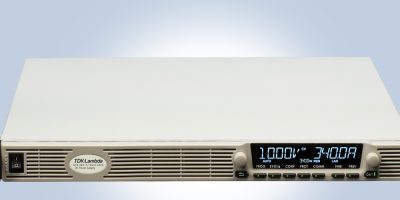A Power Sink option for programmable power supplies accelerates programming
TDK-Lambda has introduced a Power Sink (PSINK) option to the 1.7kW and 3.4kW models of its Genesys+ series of high power density programmable DC power supplies.
The PSINK option is capable of absorbing and dissipating up to 300W of peak power and 100W continuously. It can provide up to 25 times faster down programming speeds, with fall times of just 12.5ms, even under no load conditions, said the company.
The PSINK option is suitable for testing electric motors with PWM (pulse width modulated) speed control that return power to their source under motor braking conditions. Use examples include automotive electric windows, power mirrors and power seats.
The option can also be used during battery and capacitor testing to discharge after testing is complete. A rapid downtime enables shorter test cycles to be performed and more accurately simulates normal operation.
The PSINK module is mounted inside the Genesys+ power supply. It allows the power supply to absorb energy fed back from the load. This can be energy generated from suddenly stopping a DC motor or discharging a battery or capacitor, enabling the ATE (automated test equipment) to proceed to the next test quickly. The internal control logic senses the output voltage of the power supply. If the sensed voltage is higher than the desired voltage, the logic signals the PSINK module to sink current from the load, via the output terminals, and maintain a constant voltage across the load.
The option is available on the 1U high, 19 inch rack mount 1.7kW and 3.4kW rated units with output voltages of 0 to 20V, 0 to 30V, 0 to 40V, 0 to 60V and 0 to 100V.
All the programmable power supplies in the Genesys+ series operate in constant current, constant voltage or constant power limit modes. They also offer internal resistance simulation. TDK-Lambda’s parallel system allows a multiple unit system to achieve a dynamic response and ripple and noise performance comparable to that of a single power supply, said the company. A simple datalink cable enables the command and auxiliary units to auto-configure by detecting the parallel data connection and setting their parameters accordingly.
The series benefits from DSP technology and components, including ferrite materials, to obtain efficiencies of up to 92 per cent. Less internal waste heat ensures a higher power rating without compromising reliability and lower audible noise to reduce operator fatigue.
The 1.7kW and 3.4kW models are suitable for zero stack rack mounting, measuring 423mm wide, 441.5mm deep and 43.6mm (1U) high. Cooling is provided by variable-speed fans monitoring the ambient temperature and the output load.
The models in the series have a high contrast, wide viewing angle LCD with user-controllable brightness and dimming functions, and fast up and down programming response times, with user-adjustable voltage and current slew rate control. Arbitrary waveform test profiles of up to 100 steps can be generated and stored in four memory cells and activated by commands from the communication ports or the front panel controls.
Programming is consistent across the entire 1kW to 90kW power supply series by either front panel controls, remotely via LAN (LXI 1.5), USB 2.0, and RS232/485 communications, or by using the isolated analogue control and monitoring (0 to 5V, 0 to 10V), which are provided as standard. Optional interfaces include a choice of EtherCAT or Modbus-TCP or GPIB (IEEE488.2) or IS420 (isolated analogue current program/monitor interface 4mA to 20mA with 600V isolation). Software drivers, a waveform creator and a virtual front panel GUI are provided in the software package. Safety features are standard in all models, providing safe/auto re-start, last setting memory, and built-in protection functions. A blank front panel option, without a display, is offered to avoid unauthorised changes to the unit’s settings.




